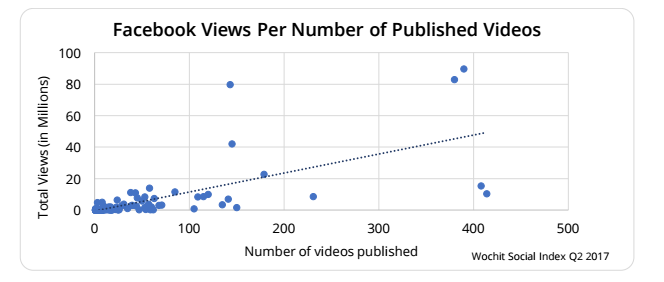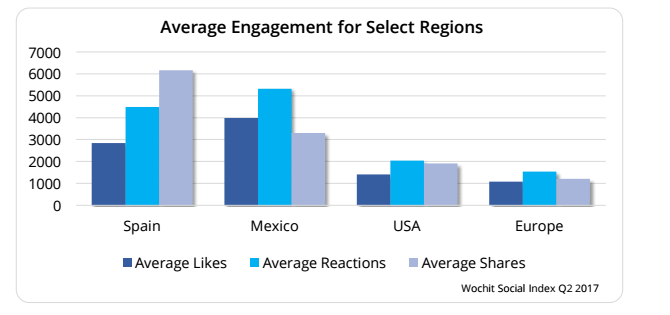Only 1 percent of videos posted to Facebook actually end up going viral — but it probably helps if your video is square rather than horizontal or vertical, is engaging in ways beyond Likes, and/or is geared toward Spanish speakers, an analysis by social video production company Wochit found.
Wochit analyzed more than 5,000 social videos that were created by more than 100 publishers between March and May 2017. It compared the results to the three-month period between December 2016 and February 2017.Wochit uses artificial intelligence to create and help distribute short-form social videos around trending topics for various media companies including Time Inc., Gannett, and Der Spiegel. (Last year, The New York Times’ John Herrman took a look at Wochit and its rival video automation company, Wibbitz.) This study was based off of the video content it has developed and shared for its clients.
— More video, more money: Earlier this year, 75.95 percent of Wochit’s publishers said they planned to push video as a strategy for increased engagement and revenue. The analysis found a strong correlation between the number of videos posted on a Facebook page and the total number of views received.
 — Being square is no longer a bad thing: Who needs vertical or horizontal framing when you can go for a square shot, which takes up 78 percent more “screen real estate in the [mobile] social feed”? Average views for square videos rose 136.6 percent over horizontal videos, with increases in the double digits for shares, likes, and comments. Most videos are still published as horizontal shots, though the number of square videos produced climbed about 10 percentage points, to 39.8 percent.
— Being square is no longer a bad thing: Who needs vertical or horizontal framing when you can go for a square shot, which takes up 78 percent more “screen real estate in the [mobile] social feed”? Average views for square videos rose 136.6 percent over horizontal videos, with increases in the double digits for shares, likes, and comments. Most videos are still published as horizontal shots, though the number of square videos produced climbed about 10 percentage points, to 39.8 percent.
— The elite one percent: Wochit defines “going viral” as hitting one million views, and the number of videos in its arsenal reaching that benchmark is consistent over the first set of data: 1.1 percent. It’s considered the “lion’s share of total engagement, receiving 43.2 percent of total views and 63.98 percent of total shares.”
— Dime más: The only countries that view/share videos more than the United States are Spain and Mexico.
26 comments:
Thanks a lot for sharing such a detailed post that is an ample proof how wholeheartedly you want to serve your customers in their best interest.
I’m gone to say to my little brother, that he should also go to see this blog on regular basis to
get updated from most up-to-date gossip.
hey there and thank you for your info – I’ve certainly picked
up something new from right here. I did however expertise a few technical issues using this website, since I experienced to reload the web site many
times previous to I could get it to load correctly.
I had been wondering if your hosting is OK? Not that I am complaining,
but sluggish loading instances times will sometimes affect your placement in google and could damage your quality score if advertising and marketing with Adwords.
Anyway I’m adding this RSS to my e-mail and could look
out for a lot more of your respective interesting content. Make sure you
update this again very soon.
Your style is unique compared to other people I have
read stuff from. Thank you for posting when you have the opportunity, Guess I’ll just book mark
this blog.
I’m extremely inspired along with your writing abilities as smartly
as with the layout for your blog. Is this a paid topic or did you modify it yourself?
Either way keep up the excellent quality writing, it’s
rare to peer a great weblog like this one today..
Thank you for sharing your info. I really appreciate your efforts and
I will be waiting for your next post thanks once again.
I am regular visitor, how are you everybody?
This piece of writing posted at this web site is actually good.
You really make it seem so easy together with your presentation but I
in finding this matter to be really something that I think I would never understand.
It kind of feels too complicated and extremely extensive for
me. I am looking ahead on your subsequent publish, I’ll attempt to get the hold
of it!
Excellent blog! Do you have any tips for aspiring writers?
I’m hoping to start my own website soon but I’m a little lost on everything.
Would you suggest starting with a free platform like WordPress or go
for a paid option? There are so many choices out there that I’m totally overwhelmed ..
Any tips? Bless you!
This is the perfect website for anyone who hopes to find out about this topic.
You realize a whole lot its almost tough to
argue with you (not that I personally would
want to…HaHa). You definitely put a brand new spin on a topic
that has been written about for a long time. Great stuff,
just wonderful!
Great delivery. Outstanding arguments. Keep up the
amazing work.
It’s genuinely very complicated in this busy life to listen news on TV, therefore I simply use web for that purpose,
and obtain the newest information.
Asking questions are really fastidious thing if you are not understanding something completely, however this article gives pleasant understanding even.
Have you ever considered publishing an ebook or guest authoring
on other sites? I have a blog centered on the same topics you discuss and would really like to have you share
some stories/information. I know my viewers would value your work.
If you’re even remotely interested, feel free to send me an email.
I am sure this post has touched all the internet viewers,
its really really nice article on building up new website.
I believe what you posted made a lot of sense. But, what about this?
what if you typed a catchier post title? I ain’t suggesting your
content is not good., but what if you added a headline that makes people want more?
I mean blog topic is a little vanilla. You should glance at
Yahoo’s home page and watch how they create post titles to get viewers to click.
You might try adding a video or a picture or two to get readers excited about what
you’ve written. In my opinion, it might bring your posts a little bit more
interesting.
I have to thank you for the efforts you have put in penning this blog.
I really hope to check out the same high-grade blog posts by you later on as well.
In fact, your creative writing abilities has motivated me to get my own site now ;)
Hurrah, that’s what I was seeking for, what a material!
present here at this website, thanks admin of this website.
Today, I went to the beach with my kids. I found
a sea shell and gave it to my 4 year old
daughter and said “You can hear the ocean if you put this to your ear.” She put the shell to
her ear and screamed. There was a hermit crab inside and it pinched her
ear. She never wants to go back! LoL I know this is completely
off topic but I had to tell someone!
Thanks for some other informative website. The place else
may just I get that kind of information written in such
a perfect method? I have a mission that I’m simply
now running on, and I have been at the look out for
such info.
It’s an remarkable paragraph in favor of all the internet users; they will obtain advantage from it I am sure.
When I originally commented I seem to have clicked on the -Notify me when new comments are added- checkbox and now every time
a comment is added I get four emails with the exact same comment.
Perhaps there is a means you can remove me from that service?
Thank you!
Fantastic goods from you, man. I’ve understand your
stuff previous to and you’re just too fantastic.
I actually like what you have acquired here, really like what
you are stating and the way in which you say it. You make it enjoyable and you still care for to keep it sensible.
I can’t wait to read much more from you. This is really a tremendous website.
bokep terbaik sma toket gede menyala banget
I do consider all the ideas you’ve presented on your post.
They are very convincing and can definitely work.
Still, the posts are too brief for beginners.
May just you please prolong them a bit from subsequent time?
Thank you for the post.
bokep terbaik sma toket gede menyala banget
Trackbacks:
Leave a comment